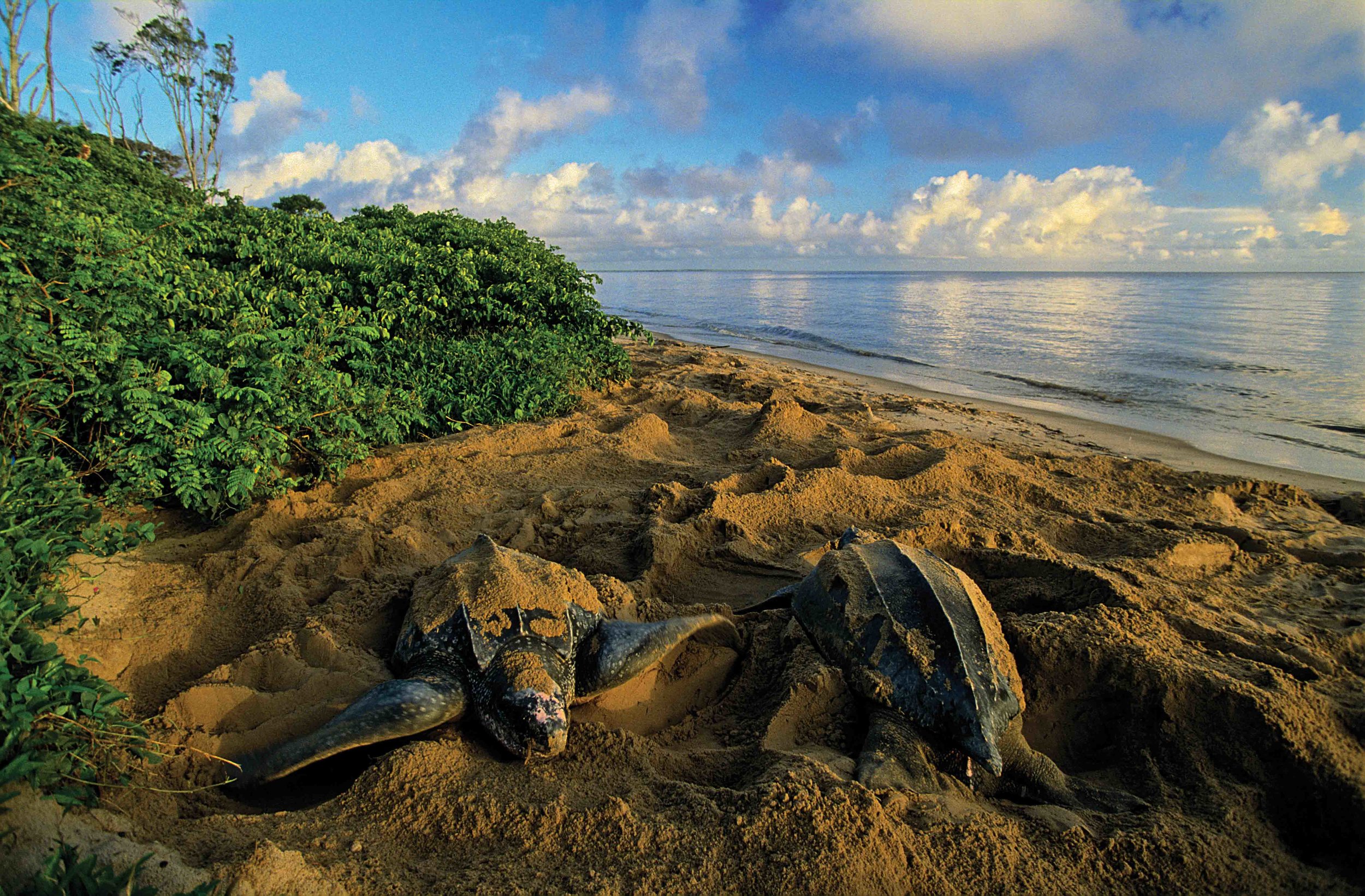Shifting Shorelines: The Lesson of the Guianas
Two leatherbacks camouflage their nests on Les Hattes beach, in front of the village of Yalimapo in French Guiana. © Olivier Grünewald
By Peter C. H. Pritchard
Nearly a decade ago, I made a trip through the Guianas— three small, tropical countries on the northern coast of South America. From Georgetown, Guyana, I traveled east into Suriname and on to Cayenne, French Guiana. I traveled outward by small aircraft and returned overland by a complex formula of taxis, minibuses, and river ferries. I passed villages galore, with crowds of people of seemingly every race on Earth waiting for ferries or bargaining for vegetables. I journeyed through agricultural areas and sugar estates. The languages changed at every border— English Guyana-style, then Dutch and Taki-taki, and then French and Creole.
But from the air, I was reminded how truly narrow that coastal band of human development really was. For hours as I flew, the impact of humans on the landscape was essentially invisible, the lumpy green carpet of the forest broken only by rivers. What a prize, I thought to myself, in a world where human overpopulation is overwhelming natural resources almost everywhere.
But sea turtles had first brought me to this coast in 1964. I was intrigued by an adult olive ridley on exhibit in the Georgetown museum. What on Earth was a Pacific ridley doing in the western Atlantic Ocean? This was a first. The rumor in the city was that sea turtles nested at Shell Beach, and so I went there. By the time I arrived, the turtle hunters had done their work for the season. Everywhere lay shells and skulls of slaughtered turtles—hawksbills, greens, and ridleys—and one or two old leatherback skulls. However, these carcasses represented the first vouchered nesting records for all four species for South America. I returned the next year during nesting season and tagged mostly hawksbills. The hawksbills were unusually large, but the green turtles were huge—twice the weight of greens from Tortuguero in the western Caribbean.
In later years, I worked the beaches of eastern Suriname, where I saw not only my first nesting leatherbacks, but also the olive ridley arribada at Eilanti, a small beach overlooking the broad Marowijne estuary. Later still, following a tip-off from fishers, my colleagues and I discovered the Holy Grail of nesting sites—the open-sea beach of Silébache in French Guiana, where approximately 300 turtles nested each night.
Forty-three years later, I still work with turtles of the Guianas. I have remained intimately involved with the Guyana effort, now an Arawak-run project—an excellent example of local stakeholder involvement. I have witnessed vast changes. Shell Beach washed away years ago, and the turtles have rotated through a series of other beaches. Each season, we set up conservation camps on two or more important beaches, as opportunity presents. The leatherback is now the most abundant turtle by far, while ridleys have mostly left the scene. We have seen a progressive, although unsteady, upsurge in nesting, and we are still trying to understand the 2000 season, when we had about 10 times more turtles than ever before—nearly all leatherbacks.
In Suriname, some beaches have disappeared, while others have shifted, grown, or stabilized. The Galibi River beaches are stable, with important leatherback colonies. The ridleys have mostly left Eilanti— now choked with silt behind a mud bank—and are relocating to Montjoly beach, east of Cayenne, and to Brazil. For several years in the 1990s, a new beach—Samsambo—in front of the Eilanti mud banks was colonized by leatherbacks.
Since the “discovery” of French Guiana’s leatherbacks in the late 1960s, the country has been known to be the home of one of the largest leatherback nesting colonies in the world. Leatherbacks lost their open-sea beach to erosion around 1973, forcing most of the nesting into the Mana River mouth. Today, however, leatherback nesting in French Guiana has rebounded along all the oceanfront beaches, with 60 percent of turtles nesting on the open coast and 40 percent on the more protected estuarine and river beaches.
The lesson of the Guianas is that we cannot know the parameters of a turtle population after a single visit, a single month, or even a single year. Turtles are here for the long haul, having endured rising sea levels and similar drastic changes many times throughout their ancient histories. They have survived by making adjustments. We, as conservationists, must prepare for changes. We must adapt, we must make adjustments, and—like the turtles themselves—we must be in it for the long haul.
Peter C. H. Pritchard is one of the world’s foremost experts on turtles and tortoise and founder of the Chelonian Research Institute.
This article originally appeared in SWOT Report, vol. 3 (2008). Click here to download the entire article as a PDF.


